18 December. Desert Locust situation remains serious in Sudan
The current Desert Locust situation remains worrisome in Sudan. During the first week of December, groups of adults and a few swarms moved from the northern interior to Wadi Diib in the northeast near Egypt and to the central Red Sea coast. Adults were laying eggs in both places. Some of these eggs have already hatched in Wadi Diib. Nearly 4,000 ha were treated by ground and aerial teams during the first half of the month. There is a high risk that locust numbers will increase significantly this month as hatching continues. The risk of additional movement across the Red Sea from Sudan to Saudi Arabia will decline as adults mature.
So far, only low numbers of adults were seen laying eggs in southeast Egypt, adjacent to the infestations in Sudan. In Yemen, small-scale breeding is in progress on the Red Sea coast where scattered solitarious adults and hoppers are present.
Small infestations of groups of hoppers and adults persist in Pakistan along the Indo-Pakistan border where survey and control operations continue.
In West Africa, small groups of adults were present and laying eggs in northwest Mauritania where limited concentrations of hoppers were present. Ground teams treated 880 ha during the first decade of December.
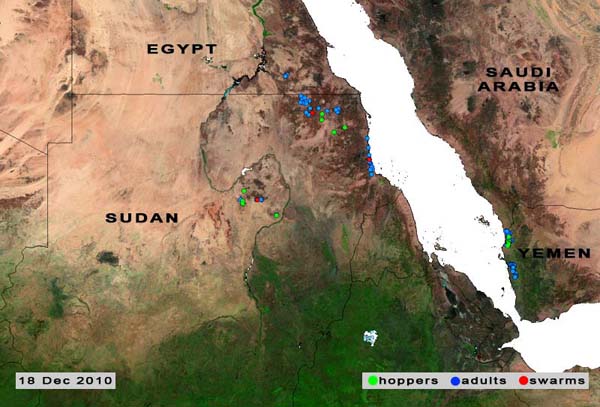
Locusts increase in NE Sudan.
2 December. Desert Locust situation remains potentially serious in several countries
The Desert Locust situation continues to remain a cause for concern in Sudan. Despite control efforts during November, adults formed small groups that moved to northeast Sudan and laid eggs while several other groups crossed the Red Sea to the northern coast of Saudi Arabia. If good rains fall in either country, locust numbers could increase rapidly and threaten the region. Therefore, it is essential that the highest priority be given to deploying additional survey and control teams in the field immediately in both countries. Elsewhere, the current situation is being monitored closely along the Indo-Pakistan border where control operations continued in November against gregarious infestations, in northern Mali and Niger where the situation is not entirely clear but locusts are likely to be present and gregarizing, and in northwest Mauritania where breeding and limited control operations are underway for the second consecutive month.
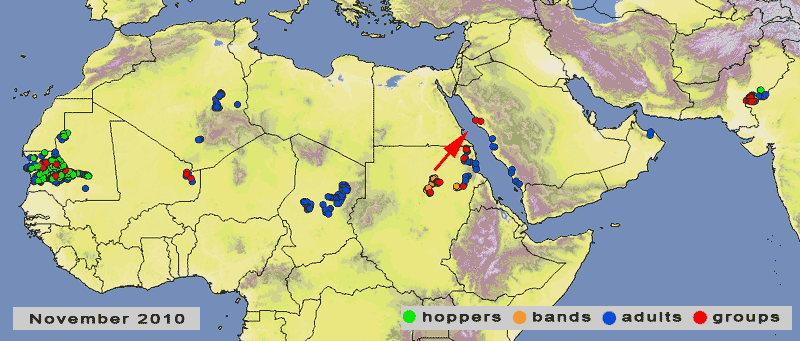
Locust activity increases in several countries.
4 November. Locust activity increases in several countries
As a result of good rainfall and breeding during the summer, locust numbers have increased in Mauritania, Niger, Sudan, Pakistan and India. Vegetation is now drying out and the locusts are concentrating, increasing in density and, in some cases, changing from solitarious to gregarious, forming groups of hoppers and adults, hopper bands and a few small swarms. National control teams have been mobilized in Mauritania, Sudan, Pakistan and India.
The situation is most serious in northern Sudan where several hopper bands and at least one swarm has formed in the remote Baiyuda Desert. Unless controlled, locusts will increase further and move towards the winter breeding areas along both sides of the Red Sea.
National teams in India and Pakistan are controlling infestations that straddle both sides of the border in Rajasthan and Cholistan. These operations should reduce the scale of migration west to the spring breeding areas of western Pakistan and southeast Iran.
In Mauritania, locusts have concentrated in the west where good rains fell and breeding is expected to continue until the end of the year. Consequently, there is a high risk the locusts could increase rapidly and eventually threaten northwest Africa. Treatment of the largest and densest infestations is aimed at reducing this possibility.
In Niger, locusts are concentrating in between the dunes of central Tamesna where vegetation remains green. Here, they are likely to form small dense groups.
All efforts should continue to monitor the situation carefully and take the necessary control measures in a timely and effective manner.
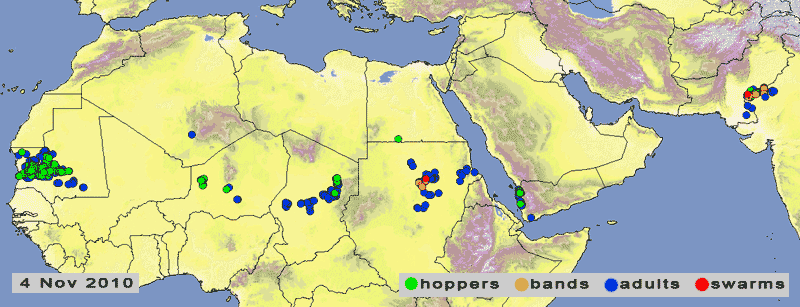
Locust activity increases in several countries.
15 October. Control operations underway along the Indo-Pakistan border
Ground teams from the national locust units in Pakistan and India are currently treating small infestations of Desert Locust hoppers and adults in desert areas along both sides of the common border. Most of the infestations are concentrating in Rajasthan, India north of Jaisalmer and in Cholistan, Pakistan south and east of Rahimyar Khan. So far this month, nearly 1,800 ha have been treated in India and 3,000 ha in Pakistan.
The situation remains calm in other Desert Locust-affected countries in Africa and the Near East. Seasonal rains have ended in most of the summer breeding areas of the northern Sahel in West Africa and Sudan. As vegetation dries out in these areas, adults in southern Mauritania will move to northwest of the country where they could form small groups, while the adults in Sudan will move to the Red Sea coast. Low to moderate numbers of locusts are likely to remain in parts of northern Mali, Niger and Chad where they could concentrate and form small groups. The latest reports indicate that locusts are appearing in northwest Mauritania where populations are increasing slightly due to small-scale breeding.
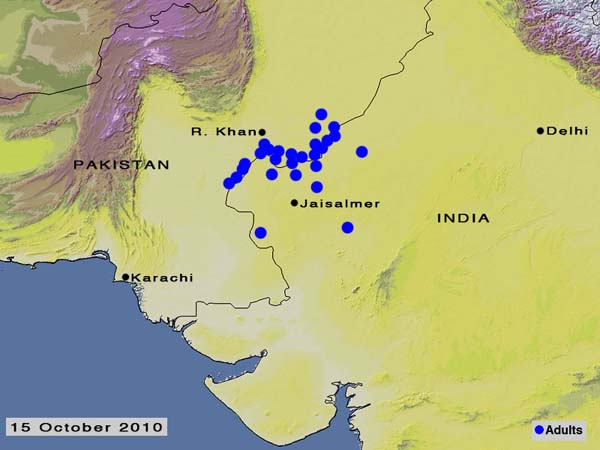
Scattered hoppers and adults are present in summer areas.
5 October. Summer rains come to an end in breeding areas between West Africa and India
The Desert Locust situation currently remains calm in all countries.
In South-West Asia, ground teams in Pakistan treated a few small groups of mature adults in the Gothki area near the Indian border. Since 18 September, more than 900 ha have been treated. As the monsoon rains appear to have ended, the locusts that are presently scattered throughout Cholistan, Pakistan and Rajasthan, India are expected to concentrate in vegetation that remains green in the border areas.
In the summer breeding areas of the northern Sahel in West Africa and Sudan, seasonal rains declined dramatically in late September. Unless further rainfall occurs, vegetation will start to dry out and the scattered locust populations that are currently present are likely to concentrate in those few areas that remain green. In addition, adults present in southern Mauritania will move towards the west and northwest of the country. Consequently, small groups may form in northwest Mauritania, northern Mali and Niger, and northeast Chad in October. Adults present in the interior of Sudan will move towards the winter breeding areas along the Sudanese Red Sea coast. Small-scale breeding is likely to occur on the Red Sea coastal plains in areas of recent rainfall, most notably on the Tihama coast of Yemen.
All efforts should be made to conduct regular surveys to monitor the situation.
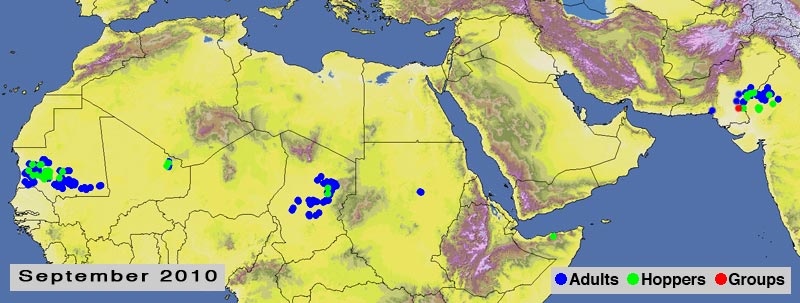
Scattered hoppers and adults are present in summer areas.
17 September. Locusts reported along Indo-Pakistan border
A mature Desert Locust swarm of 4 km by 3 km in size was seen on 15 September near the Indo-Pakistan border just a few kilometers inside Pakistan in the Gothki area south of Rahimyar Khan and west of Jaisalmer, India. The adults had settled and are ready to lay eggs. Pakistani teams are on site undertaking ground control operations and a plane has been put on standby. In India, surveys are being intensified in adjacent border areas of Rajasthan.
Both countries actively monitor the Desert Locust situation during the monsoon summer breeding period along both sides of the border by carrying out daily ground surveys. So far few infestations have been found and only low numbers of solitarious adults have been seen this year. Consequently, the swarm report is more likely to be that of a concentration of low density solitarious adults rather than a highly dense swarm of gregarious adults.
In any case, both countries should continue and intensify survey efforts in their respective areas for at least another six weeks.
Elsewhere, the Desert Locust situation remains calm in Africa and the Near East although there is a low risk that adults could concentrate in areas that remain green, particularly in northwest Mauritania and in northern Mali and Niger, and form small groups that may eventually require control.
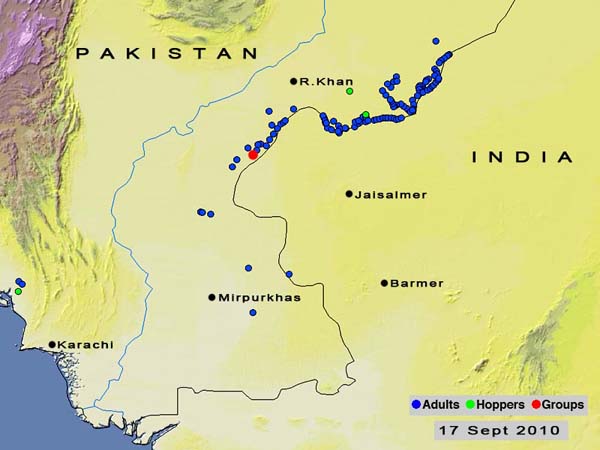
Locusts concentrate along the Indo-Pakistan border.
2 September. Small-scale breeding in West Africa and Indo-Pakistan border
The Desert Locust situation continues to remain calm despite good rainfall in the summer breeding areas of the Sahel in West Africa and Sudan as well as along both sides of the Indo-Pakistan border since July. Small-scale breeding is in progress in southern Mauritania and in Pakistan near the Indian border. It is almost certainly underway as well in parts of northern Mali and Niger, southern Algeria, eastern Chad, northern Sudan, western Eritrea, and in Rajasthan, India. Survey teams are present in most of these areas except for Mali and Niger because of insecurity.
During the forecast period, small-scale breeding will continue in the above areas and locust numbers could increase rapidly. By mid-October, there is a low risk that locusts could concentrate in vegetation that remains green and form small groups, especially in northwest Mauritania.
Efforts should continue in conducting regular surveys in all areas during the next few months to monitor the situation.
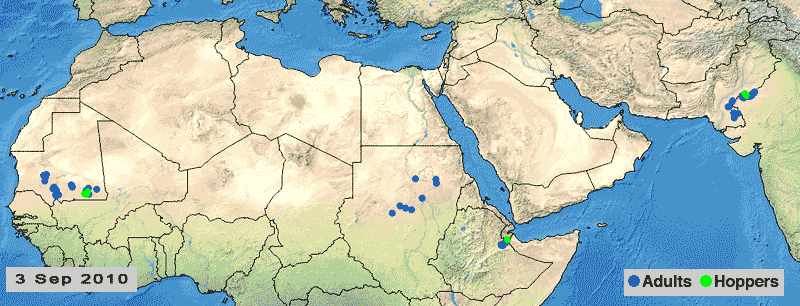
Small-scale breeding in summer areas.
3 August. Ecological conditions favourable in the summer breeding areas
The Desert Locust situation continues to remain calm in all countries. Small infestations of solitarious adults were treated in central Algeria in early July.
During the remainder of the month, only scattered adults were reported in northern Sudan. Widespread good rains fell in the summer breeding areas of the northern Sahel between Mauritania and Eritrea during July. Although surveys have yet to commence in West Africa and in the interior of Yemen, low numbers of solitarious adults are likely to be already present and perhaps breeding in some areas.
During August, small-scale breeding will occur in the above areas, causing locust numbers to increase slightly but remain below threatening levels.
All efforts should be made to conduct regular surveys during the next few months to monitor the situation.
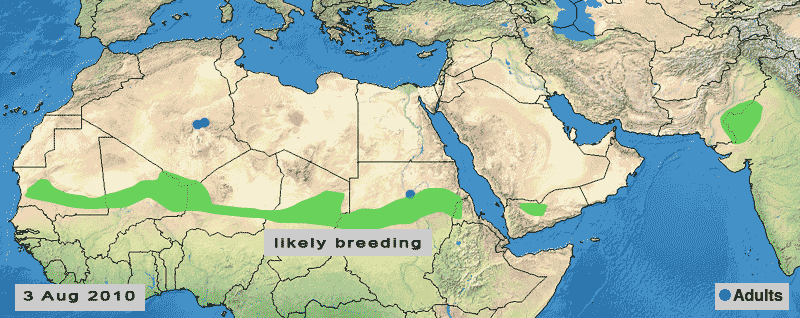
Conditions favourable in the summer breeding areas.
2 July. Ecological conditions improving in the summer breeding areas
The Desert Locust situation continues to remain calm in all countries. Ground control operations were undertaken last month against low numbers of locusts in Morocco and Algeria, and against small hopper bands in the interior of Saudi Arabia. Consequently, locust numbers have declined in these areas.
Currently, scattered mature adults are present in crops along the Nile in northern Sudan, isolated adults are present in the interior of Egypt, Yemen and Oman, and small-scale breeding is underway in eastern Ethiopia.
Low numbers of solitarious adults are expected to move south from the spring breeding areas in Northwest Africa to the summer breeding areas in the northern Sahel of West Africa. Seasonal rains commenced last month in southern Mauritania, northern Mali and Niger, eastern Chad and in central Sudan. Ecological conditions have become favourable for small-scale breeding to take place during July and August, which will cause locust numbers to increase but they should remain below threatening levels.
Breeding conditions are expected to be unusually favourable for the next few months in northern Oman, along the coast of Pakistan, and on both sides of the Indo-Pakistan border where heavy rains fell in early June from Cyclone Phet.
Consequently, ground surveys should be carried out on a regular basis during the coming months.
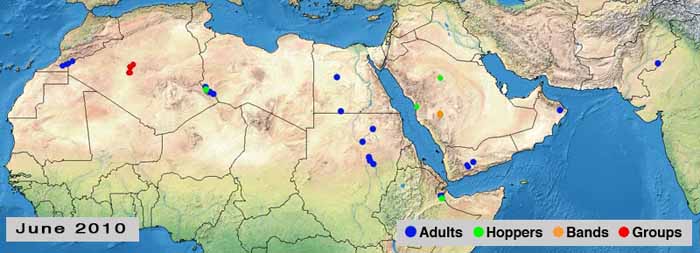
Scattered adults appear in parts of the summer breeding areas.
3 June. Limited control operations in spring breeding areas
Small-scale breeding occurred in Northwest Africa and on the Red Sea coast, causing locust populations to increase slightly. Ground control operations were carried out during May in Morocco (1,495 ha) on the southern side of the Atlas Mountains in the Draa Valley near the Algerian border, in central Algeria (348 ha) and in southwest Libya (40 ha). Control continued until mid May against small hoppers bands on the Red Sea coast near Jeddah, Saudi Arabia (2,695 ha).
Currently, the Desert Locust situation is calm. Low numbers of adults are expected to appear in the summer breeding areas in the northern Sahel of West Africa (Mauritania, Mali and Niger) and Sudan, as well as along both sides of the Indo-Pakistan border. Small-scale breeding will commence with the onset of the seasonal rains but initial locust numbers will remain below threatening levels.
There is a low to moderate risk of a few small adult groups crossing the Red Sea from Saudi Arabia to the interior of Sudan in June. As a result of the heavy rains expected from cyclone Phet (see below), ecological conditions are likely to improve and eventually become favorable for breeding in northeast Oman, southeast Pakistan and western India.
Cyclone Phet update
Tropical Cyclone Phet has intensified in the Arabian Sea just off the coast of northeastern Oman. On 2 June, the cyclone was about 300 km off the Oman coast with winds of up to 280 kph. It is moving towards the northwest and is expected to reach the Oman coast (Sharqiya region) in the afternoon of 3 June. It is then likely to turn east on the following day, reduce in strength, cross over the northern Arabian Sea and reach the coast of Sindh, Pakistan and Gujarat, India on 7-8 June. Heavy rains are forecasted for Sharqiya, Oman and coastal areas from Baluchistan, Pakistan to Gujarat, India, including Desert Locust summer breeding areas in the Tharparkar Desert, Pakistan and adjacent areas of Gujarat and southern Rajasthan in India.
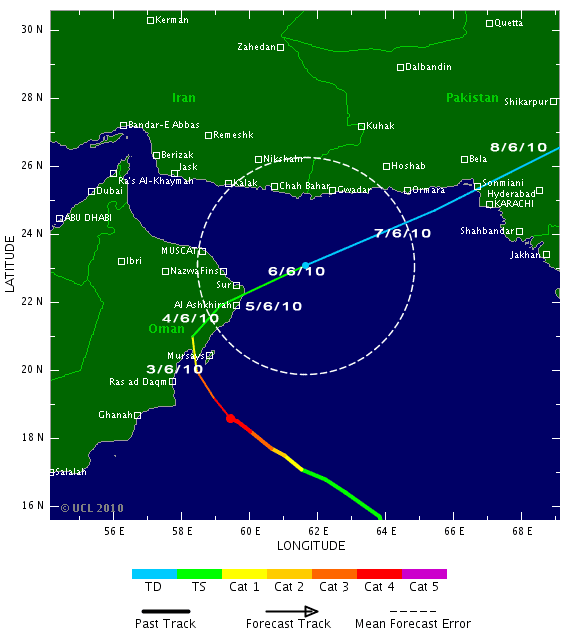
Tropical Cyclone Phet could cause heavy rains in Oman, Pakistan and India.
3 May. Calm situation continues in all countries
The Desert Locust situation remains calm in all countries. Ground teams in Saudi Arabia continue to treat numerous small hopper bands in one area on the Red Sea coast north of Jeddah in order to reduce the risk of new adults forming groups that could move into the spring breeding areas in the interior. Nevertheless, there is a good chance that some groups will form and move into areas of recent rainfall where they will mature and lay eggs in May.
Elsewhere, only low numbers of solitarious adults are present south of the Atlas Mountains in Morocco near the border of Algeria. Small-scale breeding has occurred in southwest Libya and on the southern coast in Yemen.
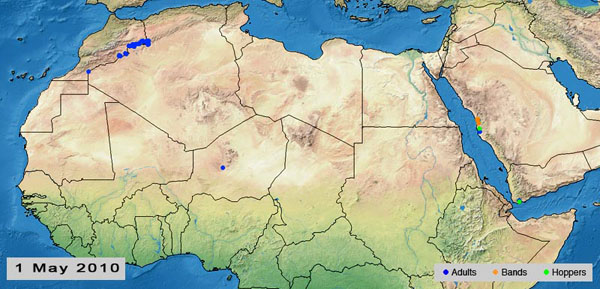
Locust control operations on the Red Sea coast in Saudi Arabia increases warning level to Caution.
2 April. Calm situation continues in all countries
The Desert Locust situation remains calm in all countries because of continuing poor rainfall and ecological conditions. Ground teams treated very small hopper groups and bands that formed in one area on the Red Sea coast in Saudi Arabia and, by the end of March, the situation was reported to be under control. Elsewhere, isolated adults persist in northwest Mauritania and on the Red Sea coast in Sudan. Low numbers of adults recently appeared in the spring breeding areas along the border of Morocco and Algeria, and in western Pakistan.
During April, small-scale breeding is likely to occur in the spring breeding areas in Northwest Africa and Southwest Asia but locust numbers are expected to remain below threatening levels. There is a moderate risk that some adults could move from the Red Sea coast of Saudi Arabia into adjacent areas of the interior and breed on a small scale.
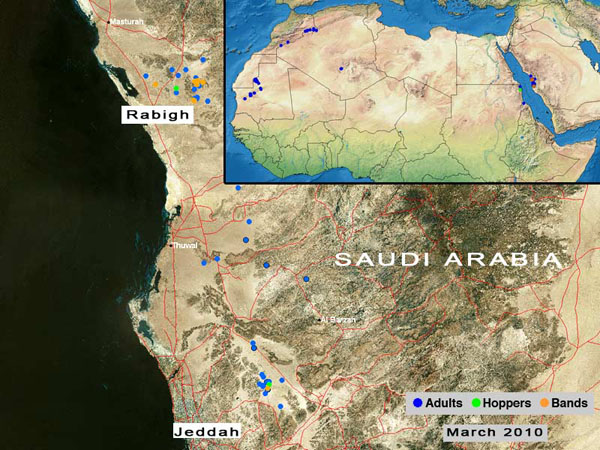
Locust infestations were treated on the Red Sea coast in Saudi Arabia.
3 March. Calm situation continues in all countries
The Desert Locust situation continues to remain calm in all countries between West Africa and southwest Asia due to a lack of rainfall and poor ecological conditions during the past few months. Nevertheless, national teams continue to undertake ground surveys and monitor the situation on a regular basis.
Currently, only low numbers of solitarious adults are present in parts of Mauritania, Libya, Sudan and Saudi Arabia. Local breeding is in progress in southwest Libya and on the central Red Sea coast in Saudi Arabia.
During March, scattered adults are expected to persist in the above-mentioned countries. If more rains fall, small-scale breeding could occur in the spring breeding areas of northwest Africa and southwest Asia but locust numbers will remain below threatening levels and no significant developments are expected.
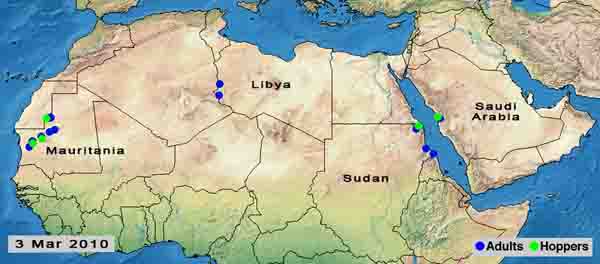
Locust numbers remain low.
3 February. Calm situation continues in all countries
The Desert Locust situation continues to remain calm in all countries between West Africa and southwest Asia.
Very little breeding has occurred this winter along both sides of the Red Sea and, consequently, locust numbers remain low. On the other hand, limited breeding occurred in northwest Mauritania and in the Air Mountains of Niger but, again, locust numbers remain low and insignificant.
Currently, only scattered adults are present in a few places on the Red Sea coast in Sudan and Yemen, in the Air Mountains of Niger, in the extreme south of Algeria near the Niger border, in northwest and northern Mauritania, and in northeast Morocco.
No significant developments are expected in the coming weeks.
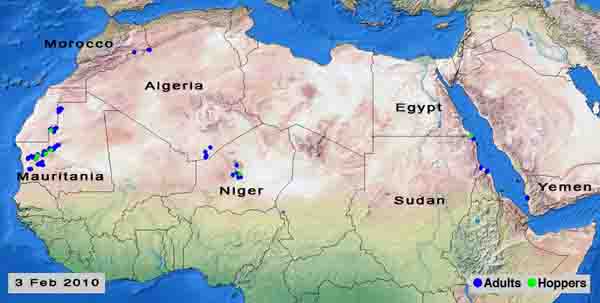
Locust numbers remain low.
12 January. Locust situation calm in all countries
The Desert Locust situation remains calm in all frontline countries between West Africa and southwest Asia.
Currently only low numbers of solitarious adults have been seen during surveys carried out this month in western and northern Mauritania, and on the Red Sea coastal plains in Sudan (in the north near Egypt and further south in the Tokar Delta). A few hoppers were also present in Mauritania.
No significant rainfall has fallen so far in January. Consequently, breeding conditions are probably less favourable than normal in the winter areas in northern Mauritania and along both sides of the Red Sea.
Nevertheless, small-scale breeding is likely to occur in a few places on both sides of the Red Sea, especially if more rains fall, while low numbers of adults are expected to persist in Mauritania, as well as in parts of Western Sahara, Mali, Niger, Algeria and Morocco. No significant developments are likely.
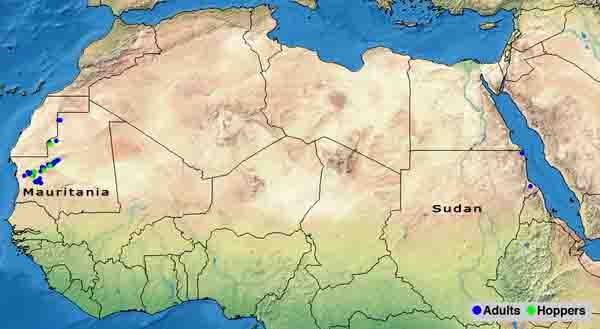
Scattered adults in Mauritania and Sudan.
4 January. Locust situation continues to improve in West Africa
The Desert Locust outbreak in western Mauritania came to an end last month and only small residual populations remain. National control teams in Niger treated locusts that had concentrated and formed small groups in green vegetation in the Tamesna. Local breeding occurred in one area of the central Sahara in Algeria and control was undertaken last month.
In the winter breeding areas along both sides of the Red Sea, limited breeding is in progress in Egypt and Eritrea while low numbers of adults are present in coastal areas of Sudan, Saudi Arabia, Yemen and northwest Somalia.
During the forecast period, small-scale breeding will occur on both sides of the Red Sea, especially if more rains fall, while low numbers of adults are expected to persist in parts of Mauritania, Western Sahara, Mali, Niger, Algeria and Morocco. No significant developments are likely.
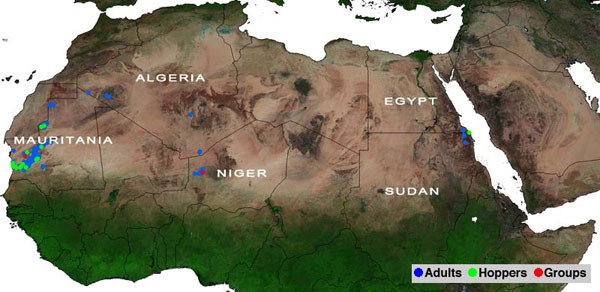
Groups of locusts are present in Mauritania and Niger.




